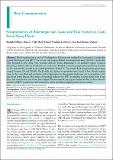| dc.contributor.author | Dolz, Gaby | |
| dc.contributor.author | Villagra-Blanco, Rodolfo | |
| dc.contributor.author | Montero-Caballero, Danilo | |
| dc.contributor.author | Romero-Zúñiga, Juan José | |
| dc.date.accessioned | 2020-08-07T16:28:15Z | |
| dc.date.available | 2020-08-07T16:28:15Z | |
| dc.date.issued | 2015-11-22 | |
| dc.identifier.uri | http://hdl.handle.net/11056/17832 | |
| dc.description.abstract | A total of 359 sheep samples from 15 farms were analyzed for the presence of antibodies against bluetongue virus (BTV) by commercial enzyme-linked immunosorbent assay (ELISA). Antibodies were detected in 290 sheep from fourteen different flocks, distributed in all analyzed regions (Central, Chorotega, Atlantic Huetar, North Huetar, and Central Pacific) determining regional seropositivity between 63.5% and 100.0%, as well as an overall prevalence of 80.8 %. The within flock seropositivity percentages ranged between 28.6% and 100.0%. Two management practices were determined as risk factors for BTV seropositivity: buying animals, embryos, or semen from other farms without any sanitary control (59.1% of the participating farms, OR= 2.54; IC= 1.49 to 4.35), and the lack of quarantine areas or separated boxes for sick animals in each flock (70.47% of the studied flocks, OR= 6.47; IC= 3.68 to 11.40). All seronegative individuals (19.2%) came from flocks that used partial stabling, indicating this management practice as a protective factor (OR= 1.10; IC= 1.06 to 1.14) for BTV infection. Flocks with the highest seropositivity were found in low altitude regions close to the coast. The results of this study indicate that BTV is endemic in sheep herds from Costa Rica, and animals seem not show clinical signs. Further epidemiological studies are required to determine serotypes present in cattle, wild and small ruminants. | es_ES |
| dc.description.abstract | Se analizaron muestras de sangre de un total de 359 ovejas de 15 explotaciones para detectar la presencia de anticuerpos contra el virus de la lengua azul (VLB ) mediante un ensayo comercial de inmunoabsorción ligado a enzimas (ELISA). Se detectaron anticuerpos en 290 ovejas de catorce rebaños diferentes, distribuidos en todas las regiones analizadas (Central, Chorotega, Huetar Atlántica, Huetar Norte y Pacífico Central) determinando una seropositividad regional entre el 63,5% y el 100,0%, así como una prevalencia global del 80,8%. Los porcentajes de seropositividad dentro de la bandada oscilaron entre el 0% y el 100,0%. Las bandadas con la seropositividad más alta se encontraron en las regiones de baja altitud cercanas a la costa. Los factores de riesgo y de protección determinados en el presente estudio no estaban en consonancia con esta enfermedad transmitida por los insectos. Los resultados de este estudio indican que el virus de la lengua azul es endémico en los rebaños de ovejas de Costa Rica, y los animales parecen no mostrar signos clínicos. Recomendamos que se lleven a cabo nuevos estudios para determinar la presencia del virus de la lengua azul en cabras y rumiantes salvajes, y para identificar los serotipos presentes en el país. | es_ES |
| dc.language.iso | eng | es_ES |
| dc.publisher | Universidad Nacional, Costa Rica | es_ES |
| dc.rights | Acceso abierto | es_ES |
| dc.rights.uri | http://creativecommons.org/publicdomain/zero/1.0/ | * |
| dc.source | British Journal of Virology, 2(5): 74-79. | es_ES |
| dc.subject | OVEJAS | es_ES |
| dc.subject | VIROSIS | es_ES |
| dc.subject | ENFERMEDADES TRANSMISIBLES | es_ES |
| dc.subject | DIAGNOSTICO (MEDICINA VETERINARIA) | es_ES |
| dc.subject | RISK FACTORS | es_ES |
| dc.subject | COSTA RICA | es_ES |
| dc.subject | SMALL RUMINANTS | es_ES |
| dc.subject | ORBIVIRUS | es_ES |
| dc.title | Seroprevalence of Bluetongue and associated risk factors in Costa Rican sheep flocks | es_ES |
| dc.type | http://purl.org/coar/resource_type/c_6501 | es_ES |
| dc.description.procedence | Escuela de Medicina Veterinaria | es_ES |
| dc.identifier.doi | http://dx.doi.org/10.17582/journal.bjv/2015.2.5.74.79 | |


